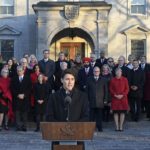Early retirement goals come with tradeoffs
/cloudfront-us-east-1.images.arcpublishing.com/tgam/BD2B2LKHQRFBTGGYUSLIIFXTPE.JPG)
Leif and Sam.
Kim Jay/The Globe and Mail
It’s been said that people begin seeking work-life balance in their mid-40s, and so it is with Leif and Sam. Leif, who works in education, is 46. Sam, who works for a non-governmental organization, is 47. Together, they earn $255,000 a year.
Leif and Sam have a daughter, 6, to put through school and a big mortgage to pay off on their B.C. house before they retire. Leif will have a work pension of $61,000 a year at the age of 60, with indexing dependent on the plan’s ability to pay. Sam does not have a pension plan.
“We’re in a pretty common and confusing situation as recent homeowners in [one of] Canada’s hottest real estate markets,” Leif writes in an e-mail. “It is important for us to balance being overly focused on saving for the future and enjoying our current lives, with travel and adventures,” he writes.
“Does it make more sense to save money or pay down the mortgage?”
They’d like to retire in 15 years, ideally with their house paid off and retirement income of $96,000 a year after tax, he adds. “Can we do it?” They’re thinking of shortening the mortgage amortization when it comes up for renewal this spring. Finally, “How can we find investments with reasonable returns that are low carbon and socially and environmentally responsible – and don’t involve individual stock purchasing?”
We asked Ngoc Day, a financial planner at Macdonald, Shymko & Co. Ltd. in Vancouver. Macdonald Shymko is a fee-only financial planning firm. Ms. Day holds both the certified financial planner and registered financial planner designations.
What the expert says
Leif and Sam are spending $119,300 a year, including mortgage payments but excluding income taxes, payroll deductions and his pension contributions, Ms. Day says. They contribute $2,400 a year to their child’s registered education savings plan and $19,200 a year to their tax-free savings accounts. They have additional saving capacity of $34,800 a year.
In preparing her forecast, Ms. Day assumes a 2-per-cent inflation rate and an average annual rate of return on investments of 5 per cent. Life expectancy is 95. To be conservative, the planner assumes no indexation of Leif’s pension. “Any indexation provided will be an added bonus to their retirement income.”
First, the planner compares investing their savings and paying down the mortgage. At Leif’s 40.7-per-cent marginal tax rate, saving mortgage interest of 2.64 per cent is equivalent to earning a 4.45-per-cent rate of return in a non-registered account, the planner says. If they were to invest their savings in their tax-free savings accounts, for their investment return to beat saving mortgage interest they’d have to take on some market risk, she says.
An “apples to apples” comparison would be the guaranteed saving on mortgage interest of 2.64 per cent compared with five-year guaranteed investment certificates – with a principal guarantee and no volatility – yielding 1.8 per cent. “Overall, it makes sense to accelerate their mortgage pay-down,” Ms. Day says.
“That being said, they could improve their overall tax efficiency by doing both: investing their savings to their RRSPs, then using the tax refund to pay down the mortgage.”
Leif would save $40 for every $100 he contributes to his RRSP, the planner notes. For Sam, the RRSP tax savings would be about 32 per cent. “Therefore, the priority is to maximize Leif’s RRSP first.”
The invested capital will grow tax-deferred in his RRSP for many years, Ms. Day says. “Using this two-pronged approach, they’d build up their retirement savings, save income taxes and reduce their debt load.”
Sam and Leif are mulling shortening their amortization period when the mortgage comes up for renewal in hopes of paying it off before they retire. They could achieve the same thing by making lump-sum payments to their mortgage, the planner says. The mortgage principal would be reduced quickly and the interest charges over the life of the mortgage would be minimized. Making lump-sum payments would also give them more flexibility in case of unexpected expenses.
Next, the planner looks at the couple’s goals of retiring at the age of 60, mortgage-free, with after-tax spending of $96,000 a year. In this they face some tradeoffs, she says. “This couple have a lot of debt and good income, but they must decide whether they are going to enjoy life now or retire early.”
While Leif’s DB pension entitlement provides a solid base for their retirement income, based on the above assumptions, retiring at 60 with $96,000 after tax income will be challenging, Ms. Day says. “They may run out of savings around age 73.” At that point, they’d need to downsize their home to release capital for retirement spending.
One alternative is to work longer. If Leif and Sam are willing to work to the age of 65, they’d improve their retirement outcome because they’d have more years at high earnings to pay down their debts, build their RRSP assets, and augment Leif’s DB pension entitlement, the planner says.
Another alternative is to reduce some discretionary spending now – for example, their travel budget of $24,000 a year – and use the savings to pay down the mortgage, she adds. “By accelerating mortgage payments, they could reduce the mortgage substantially by age 60, and may potentially achieve their goal of retiring at age 60 with little debt.”
Next, the planner looks at the couple’s investments, which are in a number of socially responsible mutual funds at their financial institution.
“I’d suggest that Leif and Sam consider a two-step process in their investment planning,” Ms. Day says. First, they need to determine the asset allocation targets appropriate for their entire portfolio – for fixed income, equities and real estate investment trusts, all geographically diversified. “The asset allocation targets should be tailored to their combined risk profile,” the planner says. The targets serve as the foundation upon which all future investment purchases or rebalancing activities will be designed,” she says. “This will help build discipline in their investment process, and help them avoid chasing the hottest and latest favourites.”
Once the asset allocation targets are set, they could use exchange-traded funds with an environmental, social and governance (ESG) focus to align with both their desired targets and their life values, rebalancing as needed to keep the allocations within the target range.
While their current portfolio holds mutual funds with socially responsible investment mandates, it is not clear whether there is an overall asset allocation target across all accounts, or if any rebalancing strategies are in place, Ms. Day says. In addition, mutual funds tend to have higher management expense ratios than ETFs. “A wide selection of ETFs with an ESG focus is available to provide both diversification and low costs,” the planner says.
Client situation
The people: Leif, 46, Sam, 47, and their daughter, 6
The problem: How to find a balance between enjoying life now and saving for retirement. Finding socially responsible investments that don’t disappoint.
The plan: Contribute to their RRSPs and use the tax refunds to pay down the mortgage. Consider working longer or cutting current spending. Set asset allocation targets in line with risk profile and switch to socially responsible ETFs.
The payoff: A better sense of the tradeoffs necessary when seeking to achieve a lifestyle balance.
Monthly net income: $15,285
Assets: Cash $56,770; house $866,700; his RRSP $105,440; her RRSP $88,120; his TFSA $14,370; her TFSA $12,035; RESP $22,665; estimated value of his DB pension $504,000. Total: $1.67-million
Monthly outlays: Mortgage $2,150; property tax $350; home insurance $140; utilities $280; transportation $240; groceries $1,200; child care $275; clothing $100; gifts, charity $300; vacation, travel $2,000; dining, drinks, entertainment $800; personal care $50; sports, hobbies $300; health, dental insurance $820; life insurance $165; disability insurance $270; doctors, dentists $200; phones, TV, internet $300; RESP $200; TFSAs $1,600; his pension plan contributions $645. Total: $12,385
Liabilities: Mortgage $540,000
Want a free financial facelift? E-mail finfacelift@gmail.com.
Some details may be changed to protect the privacy of the persons profiled.
Be smart with your money. Get the latest investing insights delivered right to your inbox three times a week, with the Globe Investor newsletter. Sign up today.
Published at Fri, 12 Feb 2021 23:00:00 +0000





Comments
Loading…